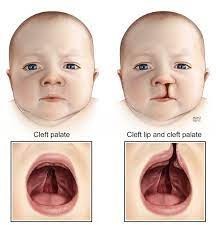During the first few days after surgery for cleft lip, which intervention should the nurse implement?
Apply Neosporin to avoid Infection.
Apply elbow immobilizers when not being held.
Suction secretions away from the suture line.
Feed Increased amounts of formula to prevent weight loss.
The Correct Answer is C
Suctioning secretions away from the suture line helps maintain the surgical site's cleanliness and promotes healing. It helps prevent accumulation of mucus or oral secretions that can interfere with the healing process and increase the risk of infection. The nurse should use a gentle suctioning technique to avoid disrupting the surgical site.
Applying Neosporin to the surgical site is not typically recommended unless specifically prescribed by the healthcare provider. It is important to follow the provider's instructions regarding wound care.
Applying elbow immobilizers when not being held is not necessary for cleft lip surgery. Elbow immobilizers are usually used in other surgical procedures or for other reasons, such as preventing contractures.
Feeding increased amounts of formula to prevent weight loss is not an appropriate intervention for the first few days after cleft lip surgery. The surgical site may be sensitive, and the child may experience difficulty with feeding initially. The nurse should provide guidance and support for feeding techniques appropriate for the child, which may include using specialized bottles or positioning techniques.

Nursing Test Bank
Naxlex Comprehensive Predictor Exams
Related Questions
Correct Answer is ["C","D","E"]
Explanation
The nurse explains that immobilizing a fracture will:
- Help align the bone fragments and reduce movement, which is crucial for proper healing. Immobilization can help maintain the stability of the fracture site, allowing the bones to knit together and heal.
- Help to minimize movement and subsequent pain. It provides support and reduces stress on the injured area, which can help alleviate discomfort and promote a more comfortable healing process.
- Help to minimize movement and reduce the risk of fat globules from bone marrow entering the bloodstream and causing a fat embolism, a potentially serious complication.
Preventing blood clots, preventing malignant hyperthermia, and immobilizing a fracture are not directly related. Preventing blood clots typically involves other measures such as early mobilization, elevation, and medication to prevent deep vein thrombosis. Malignant hyperthermia is a rare, potentially life-threatening reaction to certain medications used during anesthesia, and immobilization does not directly prevent it.
Correct Answer is ["1.4"]
Explanation
We know that 7,000 units is equivalent to 5,000 units per ml. So, we can set up the proportion:
7,000 units / 5,000 units per ml = x ml / 1 ml x = 7,000 / 5,000
x = 1.4
Therefore, the nurse should administer 1.4 milliliters (ml) of heparin.
Whether you are a student looking to ace your exams or a practicing nurse seeking to enhance your expertise , our nursing education contents will empower you with the confidence and competence to make a difference in the lives of patients and become a respected leader in the healthcare field.
Visit Naxlex, invest in your future and unlock endless possibilities with our unparalleled nursing education contents today
Report Wrong Answer on the Current Question
Do you disagree with the answer? If yes, what is your expected answer? Explain.
Kindly be descriptive with the issue you are facing.
